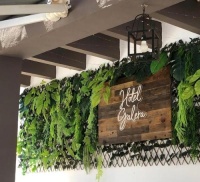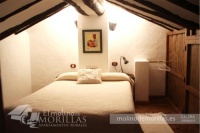Galera
The village of Galera is a natural beauty spot, which is steeped in the history of many cultures going back some 4,000 years. With a population of less than 1,500, this unspoiled village in the Granada 'Altiplano' area and is one of the six villages with makes up the Huescar region within that area. Galera has a spectacular surrounding landscape including remarkable sparkling crystal deposits, where an interior lake has dried out over the years, leaving fascinating rock formations. It is about 150 kilometres from Granada City and at an altitude of around 830 metres above sea level its geographical situation is dominated by the surrounding mountains of Sagra, Castril, Cazorla.
It is a land of contrasts, with rivers flowing through lush, green valleys, juxtaposed with dry areas where plant life has to adapt to the drought conditions. As well as the many types of flora, species of fauna such as rabbits, hares, foxes and partridge are just a few examples of those who enjoy this natural habitat. Along the river banks, willow, poplar and ash trees form a cool forest of shade in the summer months. Fish, crabs and turtles abound, as well as eels and much more.
The surrounding countryside is perfect for walking and cycling and many more outdoor sports.
Hotels in Galera
Hotels in Galera
History
Galera, like the other villages in the Altiplano area of the Granada Province is of special interest to historians and anyone who enjoys learning about the evolution of mankind through ancient cultures. There are traces of life in these parts going as far back as 2000 B.C. After the Bronze Age inhabitants came the Phoenicians, with their alabaster gods. During that time the area was called Tútugi.
Later, the Romans arrived and fell in love with the very beautiful surroundings and so they built temples, impressive villas and monuments. When the Moors came over from Africa, both the name and the position changed. Upon arrival to what was then Tútugi, the new settlers began to build the fortified walls around what became known as Galera.
There were numerous battles between Moors and Christians and many thousands of lives were lost in bloody conflict. The geography of the area changed considerably in the 19th century with the advent of the railway lines which passed by on the periphery of the area. Although the lack of direct connection and mod cons was seen by many as a life sentence to the area, looking back on it now, it is considered by many as a blessing that has managed to preserve the historical and cultural value of Galera.
Holiday Homes in Galera
Book Holiday Rentals in Galera
Things to See
Iglesia de la Anunciación
The Church of the Annunciation
This magnificent building is built in the Granada 'Mudejar' style from the 16th Century. In 1983 it was officially given status as a National Monument. If you visit this church, you will be astonished at the incredible crafted wooden roof inside the main part of the church. The chapel of 'el Santo Cristo de la Expiración' is in the baroque style with ornate plaster decoration from the 17th century, while the Main Alter is in the 20th century baroque style copied from a previous altarpiece which was destroyed during the Spanish Civil War.
Archaeological Museum
There is an archaeological museum in the chapel of the old convent in Calle San Marcos. On two floors of exhibits, you can see many pieces of historic evidence of the centuries of different cultures in and around Galera. There is also an old underground bodega, where the traditional Galera wine cellar is recreated. There are also plans for having an ethnological museum there in the future. For further information Tel: 958 739 276 or 696 829 388.
Puente de Hierro
Iron Bridge
This very interesting piece of engineering work was constructed at the beginning of the 20th century. It spans 80 metres and is made entirely of iron, supported by 4 concrete pillars. The construction of this bridge made travelling between Galera and the more northern parts of the area towards Baza and Granada much easier.
Arabic Watchtowers
There are three watchtowers built for defence and vigilance between the Christians of Castilla and the Muslims of the kingdom of Granada. They are strategically placed for keeping watch and the two towers, Fuente Amarga and the Ozmin Tower are still in good condition. The third one, the Teón Tower has not survived the rigours of time so well, but all three are witness to the historic struggles and defences of the past.
Chozones
"Bothies"
You may notice small rudimentary rock built huts in the agricultural and dry land in the municipality of Galera. These are a similar idea to the ancient Scottish highland 'bothies'. They were used in the past by the farmers when the weather turned against them. Some are made entirely of stone and are impressive in the simplicity of construction - without the use of cement or any other material.
Tútugi Necropolis
There is an archaeological dig of great national importance, consisting of some 170 graves in tombs, over quite a large area of ground. This is in fact the largest burial area of its kind in Iberian culture (Dating from the 7th to the 3rd century BC) It was officially declared a National Historic Monument by the Spanish State in 1931.
Castellon Alto
This archaeological site, is just one kilometre from the centre of Galera on the left bank of the Galera River. This was once home to the el Algar people during the lat Bronze Age (around 1900 - 1600 BC)
Fiestas
Rosario de San Aquilino
At dusk on the 4th of January the people of the village sing the rosary and local ballads, accompanied by traditional music.
Fiesta de San Antón
This religious fiesta takes place from the 15th to the 18th of January.
Jueves Lardero (Día de la Tortilla)
Thursday before Lent ( the day of the omelette)
On the Wednesday prior to Ash Wednesday, the people of Galera go off into the countryside and traditionally eat Spanish omelette as the main food of a communal picnic.
Semana Santa - Easter Holy Week
The Way of the Cross is a cultural and religious Easter celebration of great importance. The people of the village follow the image of Jesus being carried through the streets. Religious songs from the 16th Century are sung. The procession takes place at night with images of the Holy Sepulchre and the Virgen de los Dolores, with the brotherhood and maidens of the virgin following on. This is a very beautiful and haunting procession, especially within the context of this historic rural village.
The Fiesta of Christ of the Expiration (Fiestas del Cristo de la Expiración)
This traditional religious celebration is held in the first week of August. The celebrations go on in the evening with music, food and drink and by day there are many competitions organised, such as chess tournaments, local football matches and lots of events for the children. The week's celebrations culminate with the main mass on the Sunday and the procession, when the images of Christ and the Virgin are carried through the village streets. This last day of this important fiesta attracts people from near and far and is considered a major date on the religious calendar.
Fiesta de la Virgen del Rosario
This is a religious festival held on the first Sunday in October. The people of the village form a procession at dawn and spend the day together, singing and dancing. Many of the songs are taken from 16th century prayers. There is a main mass midday and another procession at night.
Santa Lucía
On the 13th December bonfires are lit and the people gather round to sing Christmas songs. Food is cooked around the fire, barbeque style and local wines accompany the celebrations.
Misa de los Gozos (The Mass of Joy)
This is a wonderful opportunity to enjoy folklore in the historic village of Galera. From the 15th to the 23rd December, each day there is a mass leading up to Christmas Eve (Nochebuena), when beautiful 17th century songs are sung, accompanied by string instruments, tambourine and cymbals. This is a really authentic Andalusian experience in this richly historic village.
Fiesta de las Migas
On the evening of 26th December the town hall provides the ingredients and the logs to light a fire, so that everyone in the village can savour the typical dish called 'Migas'. This is a tasty Andalusian recipe, which is widely popular, consisting mainly of flour, oil, water, garlic and some meat, such as sausage, bacon, etc. The town hall even provides the wine to go with it and various groups of people help with the cooking and organisation.
Baile de los inocentes (Dance on the day of the 'Innocent Souls')
The 28th of December is the day of the Innocent Souls. Equivalent to April the 1st being April Fool's Day in UK and other countries. One of the church brotherhoods organize a special celebration where traditional dances, such as the jotas and seguidillas, which are very lively, energising and wonderful to watch.
Gastronomy in Galera
Alongside all the many wonderful Andalusian country dishes to try while you are visiting the village of Galera, two important features not to be overlooked are the excellent locally baked bread and locally produced wine. The wines are certainly well worth trying and regarding the bread, it is interesting to note that one of the local sayings about Galera is the understatement "they sell bread in Galera…" The local dishes are determined by local produce and they all encompass the authentic Mediterranean flavours. Look out for migas, the home made stews and the wonderful roasts from wood burning ovens. During the Easter and Christmas periods, there are also special seasonal sweets and deserts.
Bars & Restaurants in Galera
Bar "Manolo"
C/ Iglesia, 1
Tel: 958 739165
Bar "El Cazador"
Avda. Nicasio Tomás
Tel: 958 739195
Mesón "La Zalona"
Avda. Nicasio Tomas, 12
Tel: 958 739032
Pizzería "La Posada"
C/ Iglesia, 11
Tel: 958 739153
Restaurante "El Parador"
Ctra. de Huéscar
Tel: 958 739199
For further information on Galera:
Ayuntamiento de Galera (Galera Town Hall)
Plaza Mayor, 8
Tel: 958 739 115




